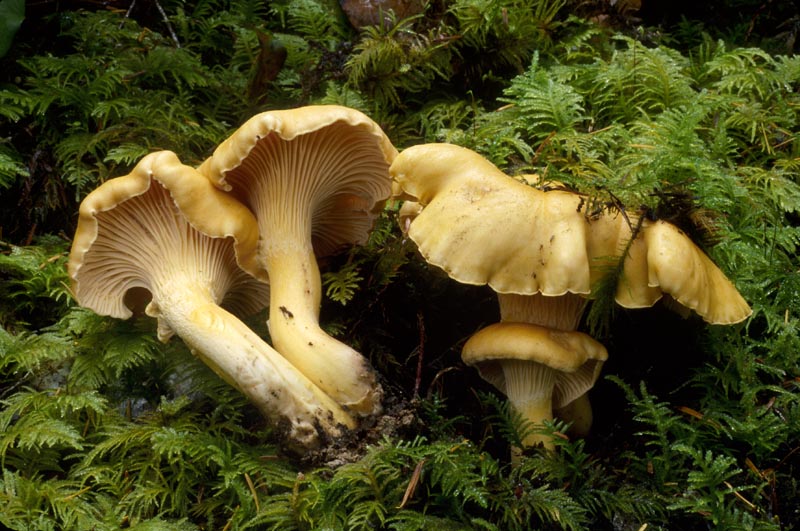
© Steve Trudell
Danny’s DNA Discoveries – Hydnaceae of the PNW
by Danny Miller
Click here for my Pictorial Key to Chanterelles and Hedgehogs.
|
|
Danny’s DNA Discoveries – Hydnaceae of the PNW
Click here for my Pictorial Key to Chanterelles and Hedgehogs. |
|
Introduction
Did you ever think you found a chanterelle and then looked underneath it and saw teeth instead of veins and realized it was a hedgehog? Some of the hedgehogs' closest relatives are chanterelles, and many people consider both to be choice edibles. Hydnums were named before chanterelles, so the family is named after the hedgehogs instead of the chanterelles. There are many unrelated false chanterelles and false hedgehogs not covered here. Real chanterelles are smoothish capped orange and black species with a particular veined to wrinkled look under the cap that runs strongly decurrent down the stem. False chanterelles have true gills or a scaly cap with a different kind of veining. Real hedgehogs have spines under the cap, "clean" orange to white cap colours and a white spore print. False hedgehogs have more sordid colours. Note that Sistotrema is polyphyletic and the type species, Sistotrema confluens, is closely related to Hydnum and is discussed on this page, but other species, like Sistotrema brinkemanii, need to be moved to various new genera. I do not cover those here because they are crusts or toothed crusts. A good overview of the Cantharellales can be found here. Every species on this page is mycorrhizal. abundant common uncommon rare - colour codes match my Pictorial Key and are my opinions and probably reflect my bias of living in W WA. Rare species may be locally common in certain places at certain times. |
|
Summary of Interesting Results
Here are some of the newest, most interesting results of the study:
|
 Cantharellus - click to expand Cantharellus - click to expand
Strongly decurrent veins/ridges under the cap that are more blunt than true gills, but can somewhat resemble true gills. Orange to whitish coloured smooth cap that may be slightly indented, but not deeply funneled. Solid stems, unlike Craterellus, whose wrinkles/veins may be very subtle and might not resemble true gills at all. |
 Craterellus - click to
expand Craterellus - click to
expand
Strongly decurrent veins or wrinkles (sometimes almost smooth) that may or may not resemble true gills at all. Slightly to strongl funnel shaped caps. Orange-brown or black colours. Hollow stems, unlike Cantharellus. |
 Hydnum and Sistotrema -
click to expand Hydnum and Sistotrema -
click to expand
Spines under the cap. Clean pale orange colouration and white spores. A recent study clarified most of the species of Hydnum around the world and can be found here. Unfortunately, many can only be distinguished microscopically at best or by DNA at worst, and morphological and ecological differences have not always been found to back up the DNA differences yet. They are not going to be identifiable on sight. |